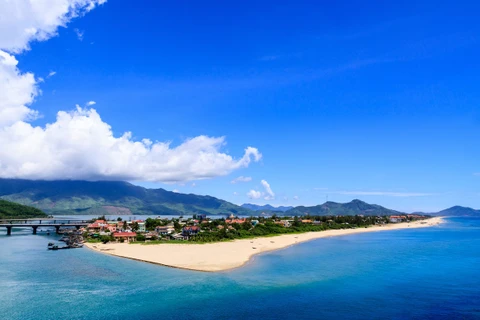Thua Thien-Hue (VNA) – The central province of Thua Thien-Hue strives to attract 3.3-3.5 million visitors and earn 3.2-3.3 trillion VND (139.1-143.4 million USD) from tourism in 2017, up 8 percent and 3 percent year-on-year, respectively.
In 2016, the Han script-language poetry on Hue royal architecture was recognised as the world documentary heritage by the Memory of the World Committee for Asia and the Pacific (MOWCAP), becoming the fifth internationally acclaimed heritage in Hue in two decades.
Other UNESCO-recognised world heritages include the Complex of Hue Monuments, Hue royal court music, woodblocks and imperial records of the Nguyen Dynasty (1802 – 1945).
To tap such advantages, the Hue Monuments Conservation Centre has actively popularised “Hue – one destination, five heritages” tours and restored a number of relics at a cost of 129 billion VND (5.6 million USD).
Nearly 130 relics have so far undergone restoration, including Ky Dai, Ngo Mon, Thai Hoa Palace, Hien Lam Cac, An Dinh Palace, complex of King Gia Long tomb, King Thieu Tri tomb, Thien Mu pagoda, among others, which cost nearly 1.2 trillion VND (52.1 million USD), more than 90 billion VND (3.9 million USD) of which was funded by foreign organisations.
The “Changing of Guards” ceremony, “wedding in royal palace” or “xam huong” (board game) also attracted visitors.
Duyet Thi Duong royal theatre, built by Emperor Minh Mang in 1826 for performances of royal music, dance and classical drama, puts on stage four shows per day.
Recognised as the world’s intangible cultural heritage since 2003, more than 40 royal court music performances have been performed at the theatre.
In 2017, the Imperial Citadel of Hue will be also open from 6:30pm to 10pm, taking visitors to Ngo Mon, Thai Hoa Palace, The Mieu, Dien Tho Palace, Truong Sanh Palace, Tu Phuong Vo Su Pavillion, Duyet Thi Duong and Imperial Household Department area.
Director of the centre Phan Thanh Hai said the centre will arrange more tour guides to give visitors an insight into the cultural, historical and religious values of Hue city as well as remarkable values of Hue royal culture, towards developing tourism into a local spearhead sector as set in the provincial Party Committee’s resolution./.
In 2016, the Han script-language poetry on Hue royal architecture was recognised as the world documentary heritage by the Memory of the World Committee for Asia and the Pacific (MOWCAP), becoming the fifth internationally acclaimed heritage in Hue in two decades.
Other UNESCO-recognised world heritages include the Complex of Hue Monuments, Hue royal court music, woodblocks and imperial records of the Nguyen Dynasty (1802 – 1945).
To tap such advantages, the Hue Monuments Conservation Centre has actively popularised “Hue – one destination, five heritages” tours and restored a number of relics at a cost of 129 billion VND (5.6 million USD).
Nearly 130 relics have so far undergone restoration, including Ky Dai, Ngo Mon, Thai Hoa Palace, Hien Lam Cac, An Dinh Palace, complex of King Gia Long tomb, King Thieu Tri tomb, Thien Mu pagoda, among others, which cost nearly 1.2 trillion VND (52.1 million USD), more than 90 billion VND (3.9 million USD) of which was funded by foreign organisations.
The “Changing of Guards” ceremony, “wedding in royal palace” or “xam huong” (board game) also attracted visitors.
Duyet Thi Duong royal theatre, built by Emperor Minh Mang in 1826 for performances of royal music, dance and classical drama, puts on stage four shows per day.
Recognised as the world’s intangible cultural heritage since 2003, more than 40 royal court music performances have been performed at the theatre.
In 2017, the Imperial Citadel of Hue will be also open from 6:30pm to 10pm, taking visitors to Ngo Mon, Thai Hoa Palace, The Mieu, Dien Tho Palace, Truong Sanh Palace, Tu Phuong Vo Su Pavillion, Duyet Thi Duong and Imperial Household Department area.
Director of the centre Phan Thanh Hai said the centre will arrange more tour guides to give visitors an insight into the cultural, historical and religious values of Hue city as well as remarkable values of Hue royal culture, towards developing tourism into a local spearhead sector as set in the provincial Party Committee’s resolution./.
VNA

























